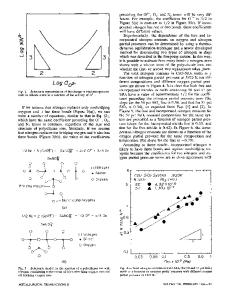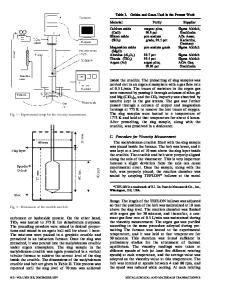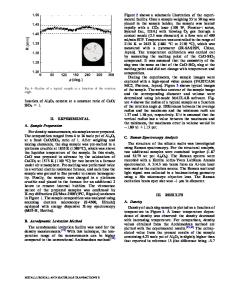Solubility of BaS in BaO-BaF 2 slag and the Influence of FeO x , SiO 2 , Cr 2 O 3 , BaCI 2 , CaO, and MgO on the sulfide
- PDF / 566,761 Bytes
- 7 Pages / 603.28 x 783.28 pts Page_size
- 63 Downloads / 338 Views
I.
Considering the gas-slag-metal Reaction [2],
INTRODUCTION
L A T E L Y , a great deal of attention has been paid to the thermodynamic properties of highly basic BaO-bearing fluxes in connection with their possible application to the refining of hot metals and steels of high chromium and manganese contents, tl-51 In a recent publication, t6] the authors showed that the BaO-BaF2 system has an extremely high sulfide capacity at 1473 and 1573 K. The purpose of the present study is to examine the influence of some additives, which are usually encountered in steelmaking practice, on the sulfide and carbonate capacities of the BaO-BaF2 system. The solubility of BaS in this system also has been measured and the activity of BaO calculated. Since a reliable measure for expressing the slag basiciLy has not been established, it is more pertinent to refer to the sulfide or phosphate capacities for comparing different slags in terms of desulfurizing or dephosphorizing power. The sulfide capacity is defined by Eq. [1]
1 [S] (metal) + 02- (slag) = S 2- (slag) + 2 02 (g) the sulfide capacity can be expressed by Eq. [3]: (mass pct $2-) 9P~)ff- K Cs 2- =
[mass pet S[ "fts]
Cs2_ = (mass pct $2-) x
[4]
, 1/2
(t:)02)
[1]
\es2 /
where (mass pct S 2-) is mass pct S in the slag and Pi is the partial pressure of i.
IVAN P. RACHEV, formerly Graduate Student, Department of Metallurgy, The University of Tokyo, is Researcher with Nippon Steel, Kimitsu, Chiba, Japan. FUMITAKA TSUKIHASHI, Associate Professor, and NOBUO SANO, Professor, are with the Department of Metallurgy, The University of Tokyo, Tokyo 113, Japan. Manuscript submitted June 28, 1991.
METALLURGICAL TRANSACTIONS B
[3]
where [mass pct S[ is mass pct S in the metal, ftsj is the activity coefficient of sulfur in the metal, and K is the equilibrium constant of the reaction of dissolution of gaseous sulfur into the metal. In the present study, silver in a nickel crucible was used as the metal. Since nickel content of molten silver after equilibration was found to be less than 0.6 mass pct, its influence onfrs J was disregarded throughout the present study. The carbonate capacity of a slag is defined on the basis of Reaction [4]: CO2 (g) + 02- (slag) = CO~- (slag)
,
[2]
(mass pct CO~-) Cco~- =
[5] Pco2
II.
EXPERIMENTAL
The principle and the procedure of the present experiments are exactly the same as the ones in Reference 6, where a gas-slag-metal equilibration technique was used. Two grams of slag and 4 g of silver in a nickel crucible were brought into equilibrium at 1473 K in a CO-CO2-Ar gas mixture. In all experiments, the oxygen potential was controlled by the CO2/CO ratio of the CO-CO2-Ar gas mixture. Water vapor in the gas mixture was carefully removed to avoid its influence on the experimental results through the possible formation of OH-
VOLUME 23B, APRIL 1992-- 175
pared. The obtained data for sulfide and carbonate capacities are represented in Tables I through III. The thermodynamic data of Fukatsu and Kozuka tTj for the reaction of sulfur dissolut
Data Loading...











